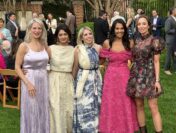
Photographer: Donald Woodman
There’s a new exhibit by Judy Chicago on view now at the National Museum of Women in the Arts that no one wants to see. It’s dark. It’s disturbing. It makes you consider death. So you won’t want to see it, but you must.
The End isn’t about the end of Judy Chicago’s career. Far from it — she’s prolific as ever! Instead, the 80 year old feminist icon is facing her own mortality on public display in this exhibition, while also tackling uncomfortable subjects, advocating for social change as she continues to push boundaries in her career.
“If you really care about life, then you care about the quality of life,” she explained as she toured the premiere viewing of her The End exhibition works at the National Museum of Women in the Arts. “I’ve always been somebody who has chosen hope. I’m still trying to choose hope and use art as a way to help us see what is happening. We created this world and we have it within our power to change this world.”

Photographer: Donald Woodman
Best known for her monumental scale work, like her mixed-media The Dinner Party installation, Chicago deliberately chose to show The End in modest scale because “the subject matter is pretty tough,” and works with some interesting materials that correlate to her subject matter — like a series of painted black glass featuring her “Mortality” and “Extinction” works that she deemed appropriate because “glass is both strong and fragile.”
Attention grabbing, but agonizing, The End isn’t easy to view. “This is the first project I have ever done in my life where I had to have a year between finishing it and showing it. Otherwise, I would have been crying at the opening,” Chicago admitted. Still, curators at NMWA have placed it so that you must walk through at least some portions to get to the mischievously juxtaposed Live Dangerously just beyond.
“Stages of Dying,” done in china paint on white porcelain, depicts an “everywoman” going through the stages of grief. “Mortality,” in a room of its own, contains a series of nine images depicting how it might be at the The End for each of us. Chicago’s handwriting on each of the pieces makes them self-explanatory — no museum placards necessary. Some are humorous (Will I did alone with my cat?). Some are anxious and fearful. One is peaceful. And then there’s the one showing the figure hooked to a machine. “This is how most people will experience it,” Chicago says matter of factly. “I’ve come to a place of acceptance for myself; I hope I will have the courage not to go through the medical mill in terms of my own dealing with this.”

Photographer: Donald Woodman
But it’s the last section, “Extinction,” that Chicago really hopes will speak to audiences.
“As difficult as the mortality section as, it was nothing compared to this,” she says of “Extinction,” a grief inducing section that took two years alone. “It brought me face to face with what we are doing to the planet,” and ends with a full relief that forces a contemplation of species extinction.
“I did not anticipate that the show would be premiered at the exact moment that we are watching our government roll back policies like the Clean Air/Clean Water Act,” she laments. “It’s amazing the denial we are watching being practiced in the world.”
All in all, The End is powerful because of Chicago’s desire to break the silence around these all too painful topics. “Can I make images that are sufficiently compelling that people will look at this subject matter?” she asks. The answer is, Yes.
Don’t miss this: Sunday, September 22nd, Judy Chicago participates in a NMWA FreshTalk about The End, signs New Views (a newly published book of her work) and discusses her legacy of artwork.


![[Vid] A Sneak Peek Inside the New Sixty Vines Foggy Bottom](http://kstreetmagazine.com/wp-content/uploads/2024/04/SV_Wine-176x133.jpg)

